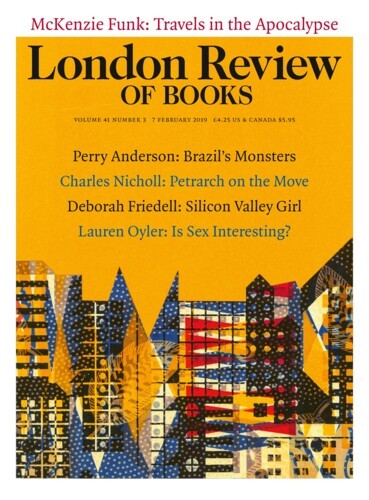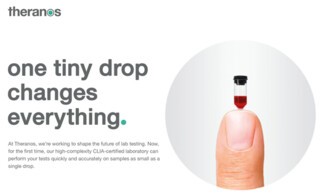Elizabeth Holmes was said to be the ‘youngest self-made female billionaire’ of all time. And why not? Her invention was going to be the reason people – Americans first, but eventually everyone in the world – would lead better, healthier, longer lives. Why shouldn’t she have a private jet, a private chef, a team of bodyguards who would say into their mouthpieces: ‘Eagle One is on the move’? She would tell her investors: ‘We’re in a market for people who don’t like having a needle stuck in their arm.’ That is: her market was everyone who isn’t a masochist. She would say that doctors make treatment decisions based on blood tests – that’s inescapable. But what if you could get accurate results from just a few drops of blood – a prick of a fingertip – rather than a full vial from a vein in the arm? And while we’re at it, wouldn’t it be better if pathologists were able to use the same blood sample to test for hundreds of different conditions simultaneously? Diabetes, sexually transmitted diseases, Lyme disease, heart disease, cancer – all would be detected in their infancies. People should be able to get their blood analysed all the time, like going to Starbucks. ‘We see a world in which no one ever has to say: “If only I’d known sooner.” A world in which no one ever has to say goodbye too soon.’ She would warn anyone who wanted to invest in her company that the established laboratory diagnostics companies, Quest and LabCorp, with their thousands of employees and billions in profits, would probably stop at nothing to prevent a Silicon Valley startup from threatening their businesses. This made her secretive, even paranoid, but then ‘only the paranoid survive,’ she’d say, quoting the president of Intel, who’d liked the saying so much he used it as the title of his memoirs.
She had been only 19 when she dropped out of Stanford, in 2004, to create the company that would become Theranos (‘therapy’ plus ‘diagnosis’), but her mentor, Channing Robertson, the emeritus chair of Stanford’s chemical engineering department, said that she ‘had somehow been able to take and synthesise pieces of science and engineering and technology in ways that I had never thought of’. He had never encountered a student like her, and he’d known thousands. ‘When I finally connected with what Elizabeth fundamentally is, I realised that I could have just as well been looking into the eyes of a Steve Jobs or a Bill Gates.’ Her family wasn’t well connected, but one of her childhood friends was the daughter of Tim Draper, the venture capitalist currently in the news for his vast holdings in bitcoin, and for spending millions of dollars in an attempt to split California into three states. Holmes had gone to him with an idea ‘for an arm patch that would simultaneously diagnose medical conditions and treat them’ – a notion that led to a blood-testing system she referred to as the ‘iPod of healthcare’. Draper staked it for a million dollars, and introduced her to his wealthy friends. The Waltons of Walmart invested early in Theranos, as did the Mexican telecoms billionaire Carlos Slim, and Betsy DeVos, the first secretary of education to own multiple mega yachts. Rupert Murdoch went in for $125 million, and Theranos grew to eight hundred employees, with headquarters in the right part of Palo Alto, on land owned by Stanford. Until they were ready to go public, Holmes ruled that Theranos was to operate in ‘stealth mode’: no published papers open to peer review, no demonstrations to anyone who hadn’t signed a non-disclosure agreement. All visitors had to be accompanied at all times, even to the loo. Holmes’s corner office – modelled on the Oval Office, and with the same arrangement of desks, sofas and armchairs – had windows made from bulletproof glass.
To reporters, to investors, Holmes would say that her technological breakthroughs were a ‘trade secret’, like the recipe for Coca-Cola. And she formed a corporate board ready to go to war with Quest and LabCorp: Henry Kissinger; Sam Nunn, who had served as chairman of the Senate Armed Services Committee; George Shultz, the former secretary of state, one of the begetters of the Bush doctrine of pre-emptive war; William Perry, the former US secretary of defence; James Mattis, Trump’s future first secretary of defence, who thought that Theranos blood tests would be a ‘game changer’ in battlefield medicine. Naturally, all those men would be useful when it came to winning defence contracts. Fortune put her on its cover (‘This CEO Is Out for Blood’), her eyes bigger and bluer than in life, very pretty and terribly young, and so did Forbes (‘The Freshman’). She was a role model now, proof that women could rise to the top in Silicon Valley, though they might have to be the right kind of woman, a woman like her. Her voice was preternaturally deep – she had trained herself to sound like a man – and she was strict about only wearing trousers and black turtlenecks, like Steve Jobs, though she made an exception for dinners at the White House.
After ten years in ‘stealth mode’, Holmes started allowing reporters to see some of the company’s tiny blood analysers, which they called ‘Edisons’. Fortune envisioned ‘one day placing Holmes’s labs right by the operating rooms in hospitals or in military evacuation helicopters or on ships and submarines or in refugee camps or in tents in the African bush’. They would, it was hoped, charge ‘a quarter to a tenth’ of the amount asked by hospital labs, ‘with still greater savings for expensive procedures’. It was the price saving that interested Fortune most. No country comes close to spending as much money on healthcare as the US – on average $10,739 per person each year, about three times the UK figure. A recent Johns Hopkins study found that this isn’t because Americans get more medical treatment, or better care, than people in other developed countries – they just pay more. This year, for the first time, American hospitals have been required to display price lists for all procedures, in theory to help patients save money by allowing them to shop around, but the information remains hard to come by. (The New York Times reported that the ‘data, posted online in spreadsheets for thousands of procedures, is incomprehensible and unusable’.) Theranos was doing something radical: circumventing hospital billing departments by selling lab tests directly to patients, at fixed prices that were clearly stated in advance.
In 2015, Theranos persuaded the Arizona state legislature to drop a law that required a doctor to order lab work. ‘This is a great day for Arizona and the future of healthcare in our state,’ the governor announced. By ‘lessening the burdensome regulations that hinder success’ Arizona was acting as a ‘model for the nation’. TV commercials directed by Errol Morris introduced the company to Arizonans: cheap, fast, no surprise bills. And, of course, no big needles: ‘Breakthrough advancements have made it possible to quickly process the full range of laboratory tests from a few drops of blood.’ Forty Theranos ‘Wellness Centres’ opened in Phoenix inside Walgreens pharmacies; Safeway spent $350 million on putting Theranos clinics in its supermarkets. Partnerships with drug companies, research institutes and health insurance providers were in the works. The goal was to perform a million blood tests in 2015, with Theranos devices ‘within five miles of every American’. The advertising agency Chiat\Day, which had made the ‘1984’ commercial for Apple to mark the emergence of the Macintosh, was put on a $6 million annual retainer to create Theranos’s campaign: ‘One tiny drop changes everything.’
In December 2014, in a New Yorker article with the subtitle ‘one woman’s drive to upend medical testing’, Ken Auletta wrote about the ‘austere life’ of Elizabeth Holmes, who ‘could quote Jane Austen by heart’, but ‘no longer devotes time to novels or friends, doesn’t date, doesn’t own a television, and hasn’t taken a vacation in ten years’. Even her board worried that she was working too hard. Henry Kissinger had ‘tried, without success, to fix her up on dates’. She told Auletta: ‘I would much rather live a life of purpose than one in which I might have other things but not that.’ He had his blood taken in a Theranos Wellness Centre, and it was just as promised: he felt no more than ‘a slight pinch’ as a phlebotomist took two drops. But as for how it all worked, Holmes would only say that ‘a chemistry is performed so that a chemical reaction occurs and generates a signal from the chemical interaction with the sample, which is translated into a result, which is then reviewed by certified laboratory personnel.’ Quite.
When Auletta’s article, ‘Blood, Simple’, was published, Holmes had just turned thirty. Another article in the same issue of the New Yorker was about the millennials who were getting rich by filming themselves playing video games. The ‘biggest star’ was a ‘Swedish gamer who goes by PewDiePie and live-snarks as he battles mutants or navigates the virtual reality of Dinotown. “Oh, God, now he’s eating my beautiful face!” he cries, on meeting a Carnotaurus. “I bet I was delicious!” PewDiePie has 32 million subscribers and earns $4 million a year.’ Auletta’s Holmes stood as a rebuke: here was a woman the same age who was also rich and becoming famous, but for the best of reasons. These other millennials – frenetic, sexist (‘Most of what’s popular is how dumb girls are’), inexplicably self-regarding – seemed to resemble her less than they did the man who, that month, would announce that he was ‘seriously considering’ running for president. To root for her seemed like picking a side.
Adam Clapper, a pathologist in Columbia, Missouri, read the New Yorker article, and – instead of bemoaning his own life choices, or pulverising ‘cucumber, parsley, kale, spinach, romaine lettuce and celery’ to make what Holmes had told Auletta was her favourite green juice – called John Carreyrou, an investigative reporter at the Wall Street Journal. Clapper thought the whole thing was preposterous. Had no one demanded proof that Holmes’s blood analyser actually worked? Silicon Valley adores its techie university dropouts – Jobs, Gates, Zuckerberg – but had anyone in the modern era ever made a breakthrough in medicine without actually having studied something? And just because Theranos centres were in Walgreens didn’t mean that any government agency had ever tested them: Auletta made it clear that the ‘labs are effectively left to police themselves.’ The grandees on her board were well equipped to plan the invasion of Liechtenstein, but none of them knew anything about blood science. Channing Robertson, the Stanford professor who might have been able to put the kibosh on the whole enterprise, would later tell the New York Times that mentoring Holmes had been like ‘teaching Einstein’ – but it was unclear how closely he had ever actually worked with her. The company also paid him $500,000 a year as a ‘consultant’. Clapper had published a short, sceptical post on his blog (‘Pathology Blawg [sic]’, now defunct), and was receiving emails from people he thought Carreyrou should interview. Clapper had been Carreyrou’s source for a previous article: he called Carreyrou because he trusted him, and because he knew that going after Theranos might well require the resources of (as it happened) Rupert Murdoch’s Wall Street Journal.
Carreyrou’s book tells the story of Theranos and of how he painstakingly took it down, which means that it’s the story of how he painstakingly found sources, and painstakingly persuaded them to talk to him on the record. One of them was Rochelle Gibbons. Her husband, an English biochemist in his mid-sixties, had been the ‘first experienced scientist Elizabeth had hired after launching Theranos’. Gibbons told Carreyrou that a non-disclosure agreement had forbidden her husband to discuss his work with her, but shortly before his suicide, he had told her that ‘nothing was working.’ She thought that whatever was happening at Theranos was the reason he’d killed himself. Another man, a former Theranos lab director, would agree to be quoted in Carreyrou’s stories only under a pseudonym. ‘Alan Beam’ said that the company had been running most of its blood samples through the standard large commercial analysers made by the German conglomerate Siemens. Theranos had to dilute their tiny samples so that they could run through the machines, but the dilution process changed their composition – the results couldn’t be trusted.
Holmes’s device, the Edison, could only run a few tests, and its ‘results were no better than guesswork’. When employees ran their own blood through it, 20 per cent of them tested positive for syphilis. An engineer said that they kept trying to improve the Edison, but it was ‘like trying to build a bus while you’re driving the bus. Someone is going to get killed.’ There was no point in complaining to Holmes, who would say: ‘If anyone here believes you are not working on the best things humans have ever built, or if you’re cynical, then you should leave.’ When she sought investors, she avoided the biotech venture capital firms that would have demanded due diligence in favour of the charmable global rich. When she led a prospective investor through the lab, one scientist mumbled: ‘Someone is about to lose their inheritance.’ It also wasn’t true that she was ascetic. She lived with her boyfriend, the company’s chief operating officer and second in command, who was in charge of security. He put Carreyrou’s sources under surveillance (they noticed they were being followed) and had them threatened with litigation; one biochemist spent $400,000 on legal fees after he was accused of violating his confidentiality agreement. The scientists who stayed at Theranos longest tended to be Indians on work visas: if they quit, they could be deported.
In the end, more than sixty people who’d worked for Theranos talked to Carreyrou, on and off the record. He was never able to get an interview with Holmes, but in 2015 she visited the NewsCorp building in Manhattan, where the Wall Street Journal and Murdoch both keep offices, and asked Murdoch to end the investigation. The Dirty Digger ‘declined to intervene’. After Carreyrou published his first article about the company a few months later, Holmes appeared on television, serene, unflappable, only slightly resentful that she had to waste her time to address what was obviously nonsense. ‘This is what happens when you work to change things. First they think you’re crazy, then they fight you, and then all of a sudden you change the world.’ She went quiet after she was arrested for fraud. She is now awaiting trial. Theranos went under, and Murdoch took a very big tax write-off. There’s no point in anyone suing Holmes – she was only a billionaire in Theranos stock – but a class-action suit against Walgreens is pending, brought by customers who say that because of their test results they underwent medical procedures they didn’t need, or were taken off medication they did need; one plaintiff says he had a preventable heart attack after being tested at a Wellness Centre for heart disease and told he had nothing to worry about. Walgreens executives had feared that if they hesitated to go into partnership with Theranos, they would lose out to their rivals.
Nothing that Carreyrou has uncovered about Holmes’s life before Theranos suggests that she had the makings of a world-class scam artist. The best he can come up with is that, as a child, she was too competitive at Monopoly: ‘When she occasionally lost, she stormed off in a fury.’ She told Auletta that she had kept ‘a notebook with a complete design for a time machine that I designed when I must have been, like, seven. The wonderful thing about the way I was raised is that no one ever told me that I couldn’t do those things.’ The old anecdotes, meant to tell one kind of story, now coldly service a different one. She thought she could do anything. ‘I think the minute that you have a backup plan, you’ve admitted that you’re not going to succeed.’ She figured that once she got the Edison to work, her lies wouldn’t matter; she’d probably win the Nobel Prize. On her desk, the one custom-designed to look like the president’s, she kept a paperweight that said: ‘What would you attempt to do if you knew you could not fail?’ She gave copies of Paulo Coelho’s novel The Alchemist to her employees, because it had taught her that ‘when you really want something, all the universe conspires in helping you to achieve it.’ Bad Blood wasn’t written to be a parable for our current moment, but it may as well have been.
Send Letters To:
The Editor
London Review of Books,
28 Little Russell Street
London, WC1A 2HN
letters@lrb.co.uk
Please include name, address, and a telephone number.



